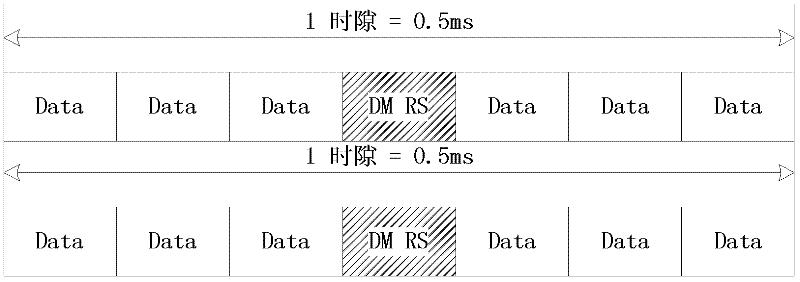Resource allocation method and resource allocation system for uplink demodulation reference signals (DMRSs)
A technology for demodulation reference signal and resource allocation, which is applied in the field of resource allocation of uplink demodulation reference signal, and can solve the problems of UE being unable to achieve orthogonality, scheduling limitation of DMRS multiplexing capacity, etc.
- Summary
- Abstract
- Description
- Claims
- Application Information
AI Technical Summary
Problems solved by technology
Method used
Image
Examples
Embodiment 1
[0059] The base station configures N resources or parameter sets for sending uplink DMRS for the user terminal through high-layer signaling.
[0060] The N resources or parameter sets used to send uplink DMRS include one or more of the following information: user-specific parameters used to determine the uplink DMRS sequence group number u, used to determine the uplink DMRS sequence shift pattern f ss The user-specific parameters of , the cyclic shift information configured by high-level signaling, and the cell-specific parameter Δ used to determine the DMRS sequence shift pattern of PUSCH ss , user-specific parameters for determining the DMRS sequence shift pattern of PUCCH, group frequency hopping enable indication, sequence frequency hopping enable indication, sequence group frequency hopping not enable indication, DMRS orthogonal mask (OCC) enable It can indicate, the number of DMRS spatial multiplexing layers, and the sequence group number of the uplink demodulation refe...
Embodiment 2
[0069] The base station configures N resources or parameter sets for sending uplink DMRS for the user terminal through high-layer signaling.
[0070] The N resources or parameter sets used to send uplink DMRS include one or more of the following information: user-specific parameters used to determine the uplink DMRS sequence group number u, used to determine the uplink DMRS sequence shift pattern f ss The user-specific parameters of , the cyclic shift information configured by high-level signaling, and the cell-specific parameter Δ used to determine the DMRS sequence shift pattern of PUSCH ss , user-specific parameters for determining the DMRS sequence shift pattern of PUCCH, group frequency hopping enable indication, sequence frequency hopping enable indication, sequence group frequency hopping not enable indication, DMRS orthogonal mask (OCC) enable It can indicate, the number of DMRS spatial multiplexing layers, and the sequence group number of the uplink demodulation refe...
Embodiment 3
[0079] This embodiment provides a DMRS configuration method, which includes that the base station can configure different uplink DMRS sequence group numbers for users with the same cell ID (such as CoMP scenario 4), so as to achieve the purpose of increasing the uplink DMRS multiplexing capacity.
[0080] by Figure 7 Take CoMP scenario 3 or Comp scenario 4 shown in as an example. If the cell IDs of the macro base station and the low-power node below the macro base station are the same, it is CoMP scenario 4. If the cell IDs are different, it is CoMP scenario 3. Taking CoMP scenario 4 as an example, according to the configuration method of the 3GPP Rel-10 protocol in the related art, the uplink DMRS sequence group numbers of users under the same macro base station are the same, and all belong to the uplink DMRS sequence group numbers of users under the low-power node They are all the same, but the number of users in CoMP scenario 4 is generally relatively large, which is prone...
PUM
 Login to View More
Login to View More Abstract
Description
Claims
Application Information
 Login to View More
Login to View More - R&D
- Intellectual Property
- Life Sciences
- Materials
- Tech Scout
- Unparalleled Data Quality
- Higher Quality Content
- 60% Fewer Hallucinations
Browse by: Latest US Patents, China's latest patents, Technical Efficacy Thesaurus, Application Domain, Technology Topic, Popular Technical Reports.
© 2025 PatSnap. All rights reserved.Legal|Privacy policy|Modern Slavery Act Transparency Statement|Sitemap|About US| Contact US: help@patsnap.com



